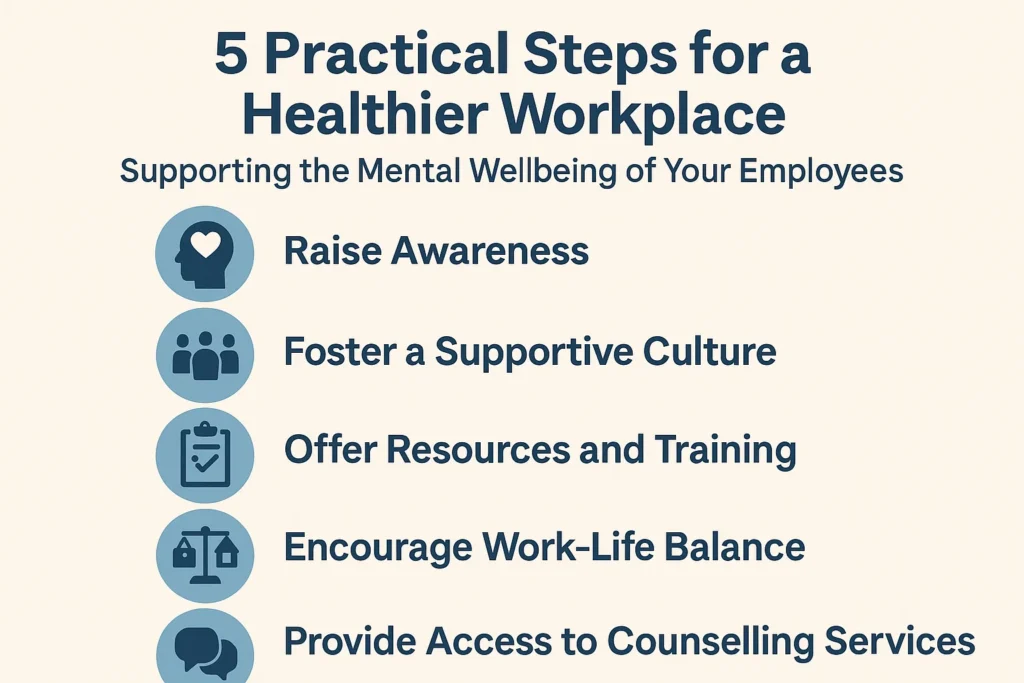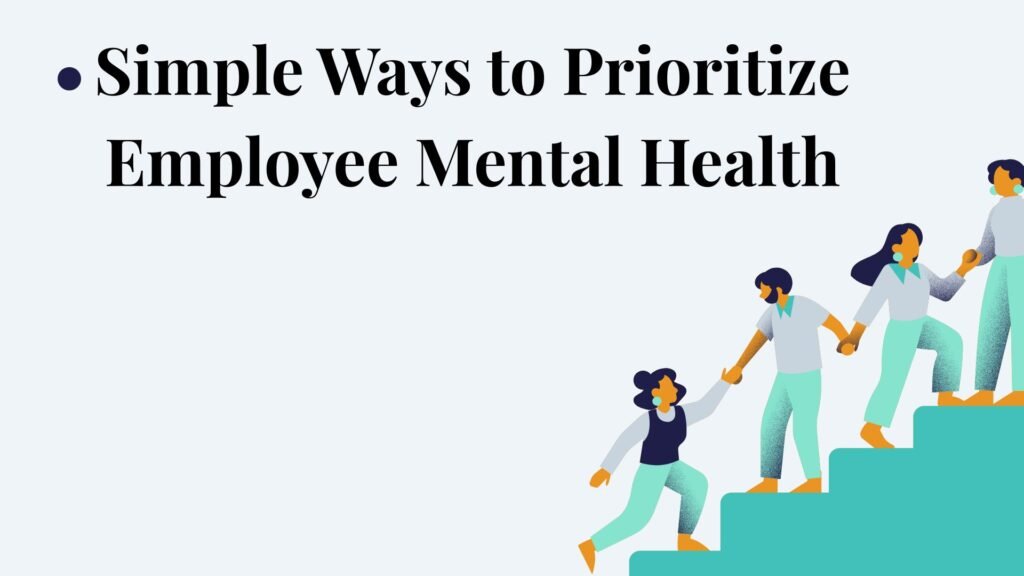Health and wellbeing:
If you have high levels of mental ill-health amongst your employees, it can have a serious impact on your business. Poor mental health in the workplace is often linked to reduced productivity, low motivation, frequent absences, and high employee turnover. In contrast, research from the Mental Health Foundation shows that businesses that actively support positive mental wellbeing tend to see increased productivity and overall performance.

Supporting the Mental Wellbeing of Your Employees:
5 Practical Steps for a Healthier Workplace
Employee mental health plays a crucial role in the overall success of any organization. When mental health issues are widespread within a team, they can significantly disrupt business operations. Common consequences include decreased productivity, low morale, increased absenteeism, and a higher turnover rate.
In fact, according to the Mental Health Foundation, businesses that foster a culture of positive mental wellbeing often report improved performance and greater employee engagement.
Research by the mental health charity Mind also reveals that 1 in 5 employees have taken time off due to work-related stress, while 42% have considered quitting their jobs because of workplace pressure.
These statistics highlight how poor mental wellbeing isn’t just a personal issue—it’s a business concern too. Yet, many employers feel uncertain about how to support their team’s mental health effectively.
In this blog, we share five actionable strategies that can help you better support your employees’ mental wellbeing and create a more positive workplace environment.

Start by Educating Yourself and Your Leadership Team
Understanding the impact of mental health in the workplace begins with education. Employers must take the time to learn about common mental health conditions, warning signs, and how these issues can affect employee performance and morale.
Mental health training courses are a great place to start. These can equip leaders with the skills to recognize mental health challenges early and respond appropriately. It’s also essential to extend this training to managers across all departments to ensure consistency in support and awareness.

When leadership actively promotes a culture of empathy and openness, it sets the tone for the entire organization.
Break the Stigma and Encourage Mental Health Conversations
Does your workplace encourage open discussions about mental health? Or is it still seen as a taboo topic?
Creating a safe and open environment where employees feel comfortable discussing their mental wellbeing is key. Start by leading with vulnerability and empathy. When leaders are transparent about mental health, it paves the way for others to do the same.

Team meetings, awareness campaigns, and even light-hearted fundraising events for mental health charities can help spark meaningful conversations. Whether it’s a walkathon, themed lunch, or charity challenge, these activities not only promote awareness but also foster team bonding and a sense of shared purpose.
Offer Practical Wellbeing Tools and Resources
Give your team access to tools that help them manage their wellbeing on a day-to-day basis. A wellness app, for instance, can enable employees to track their sleep, mood, and physical activity, helping them identify triggers and patterns.

Many of these platforms also offer tailored advice and mental health tips based on user data. For employers, anonymized insights from such tools can provide early indicators of stress or disengagement within the workforce—allowing you to offer support proactively. In addition to digital tools, consider hosting wellness workshops or mindfulness sessions. These empower employees with strategies to maintain emotional balance and manage workplace stress.
Develop a Comprehensive Mental Health Policy and Toolkit
Every business, regardless of size, should have a clear and accessible mental health policy. This policy should outline the mental health support available to staff, detail the process for requesting assistance, and explain the procedures around mental health leave and return-to-work planning.
Employers should also consider providing access to external mental health professionals, such as therapists or counselors. For employees facing more serious mental health concerns, having confidential, professional support can make a significant difference.

A mental health toolkit can also be a valuable resource. It may include self-help guides, crisis helpline information, stress management tips, and external links to organizations like Mind and Mental Health At Work, which provide a wide array of downloadable tools and resources.
Make Time for Regular One-to-One Check-Ins
Regular communication builds trust and gives employees a chance to share how they’re doing—both professionally and personally. One-to-one check-ins, whether weekly or monthly, offer a private space where employees can speak openly about their workloads, challenges, or mental health concerns.
This can be especially helpful for identifying early signs of burnout, stress, or disengagement. If your business is large, encourage department managers to carry out these check-ins consistently with their respective teams.
By maintaining open lines of communication, you can catch small issues before they escalate and show your team that their wellbeing truly matters.
Conclusion:
A Healthier Workforce Starts with Awareness and Action
Supporting your employees’ mental wellbeing isn’t just a compassionate move—it’s a strategic one. From reducing absences to improving morale and productivity, a mentally healthy workforce is a thriving one. Whether it’s through education, open conversations, accessible tools, or simply checking in, small steps lead to lasting impact. Start today by assessing what your workplace currently offers, and commit to building a culture where mental health is not only acknowledged but actively supported.

